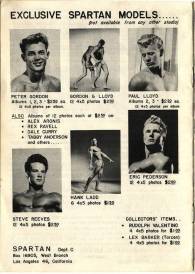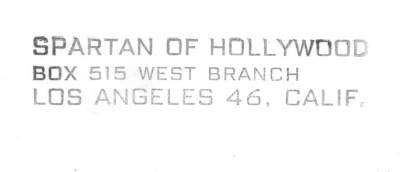(aka Konstantine or Constantine)
 PHOTOGRAPHS:
PHOTOGRAPHS:
 HIGH RESOLUTION SCANS:
HIGH RESOLUTION SCANS:
 PHOTOS IN OTHER PUBLICATIONS:
PHOTOS IN OTHER PUBLICATIONS:
 MODEL INDEX: (click here)
MODEL INDEX: (click here) IDENTIFICATION:
IDENTIFICATION:
| VINTAGE PHYSIQUE PHOTOGRAPHY | | home | magazines | movies | BIOs | updates | | contests | search | contact | |
| SPARTAN OF HOLLYWOOD (aka Konstantine or Constantine)  PHOTOGRAPHS: PHOTOGRAPHS:
 HIGH RESOLUTION SCANS: HIGH RESOLUTION SCANS:
 PHOTOS IN OTHER PUBLICATIONS: PHOTOS IN OTHER PUBLICATIONS:
 MODEL INDEX: (click here) MODEL INDEX: (click here) IDENTIFICATION: IDENTIFICATION: |
 |



 MAGAZINES AND EPHEMERA:
MAGAZINES AND EPHEMERA: Grecian Guild Studio Quarterly Number 5 |
 Spartan Volume 1 Number 1 |
 Catalog Sheets |
 OTHER INFORMATION:
OTHER INFORMATION:Hugh McCurley passed along this information about Konstantine, the man behind the camera of Spartan:
His name was Konstantine (which is sometimes spelled with a C - Constantine). He was originally a dance photographer (ballet). He took a few nudes of some of the dancers but we have no idea who or if they were stars or just the chorus members (probably the latter). He was rumored to be a student of George Platt Lynes (which I doubt, Lynes NEVER let outsiders anywhere near his studio). I assume he was doing fairly well in that field but apparently he had an overwhelming desire to become a "boy" photographer as they were then called. Anyway, he came to Hollywood and somehow met Frederick (Fred) Kovert, who took him on as one of the many, many, many photographers of Kovert Of Hollywood.
Again, much like the notorious Bob Anthony (who never picked up a camera in his life!) the gossip had it Kovert only bought photos or hired other photographers to do the work. One of my friends Cecil (C.C.) Hills was another Kovert photographer and confirmed that Kovert did NO photography. Kovert, BTW, was also an actor (started in SILENT FILMS) and for a time was also a fairly well known drag-queen! Kovert's studio was a store front on Melrose Ave in Hollywood (now West Hollywood) just a couple of blocks East of Fairfax. He had full frontal nudes on the walls as you walked in (like Lon of New York had in his walk-in studio). However, unlike New York, LA was definitely NOT READY for those kinds of displays. He was arrested in '45 or '46. (One of the very first physique photographers to be busted.)
All the photographers (or at least most of them) left and started their own "studios". That was when Konstantine started Spartan. He did take full frontal nudes but was very very discreet about them (you had to "know someone" before he'd show them to you). His little enterprise didn't last all that long and from there everyone he knew lost track of him. Where went, what he did...no one seems to know. Alive? Dead? Again, no one knows. That's all we were able to find out (about Spartan), except that he had absolutely NO CONNECTION to the Spartan Film Company which came much later.
The following was printed in Grecian Guild Studio Quarterly Number 5, written by Spartan.
Ever since the ancient Greeks depicted athletic figures on vases and bas reliefs and chiseled them out of marble, athletes have been favorite picture material. Long before photography, Praxiteles' Hermes and Michelangelo's David were world renowned. Rodin's famous sculpture, "The Thinker," has been a source of inspiration to bodybuilders and photographers alike for many years.
There are many types of athletes and bodybuilders, and each lends itself admirably to some type of picture composition. Before films and lenses attained their present day high speed and precision, the early pictorialist photographer made his best pictures outdoors in soft focus with models who emulated the postures found in well known works of art as mentioned above.
The finest photographs of this type were probably those of the late Dr. Arnold Genthe and Edward Weston. A study of the photos of this period (1914-1920), which include dancers as well as athletes, would give worthwhile ideas to present day workers for some nonprescribed subject matter which they might try treating in an up to date manner.
Suitable for outdoor photographs are the many types from the Mediterranean area and those of Slovak or American Indian descent. These athletes invariably have animation, grace and the sturdy bodies which are necessary to make a good picture subject. The most difficult part of this type of photography would be to find a suitable spot where you would have open glades with only trees and sky for background. In theory sunlight is your best light source, but it is difficult to control.
With the advent of the equipment which made studio photography possible, recording the outstanding examples of physique perfection became a relatively simple matter. Today artistic studio photographs of the male physique can be made by lensmen who are thoroughly acquainted with their subject matter.
My taste is to photograph the male body in a studio where spotlights, props and complete control over the sources of light are at my command. Most good physique photos have been conceived in a studio to present a finely executed picture to the beholder.
Physique photography is an art form all its own. It is a very special field where posing, lights, shadows and highlights are of the utmost importance. Great care must be taken to reveal the particular muscular development of each individual physique to artistic advantage.
I have often been asked, "What is the secret of good physique photography?" The answer to that question is: There is none. It is a matter of posing and lighting and nothing more. Pose and light your subject carefully. Bear in mind that shadows appear darker on the exposed film than they do to the naked eye. Move the lights about in many different angles and levels. When the lighting looks good on the subject, it will look good on the film too and ultimately in the finished print.
Physique photography as such, has become somewhat formalized in many areas. It has expressed in a series of set lighting and posing techniques: the traditional high, overhead key light, for example, and the usual displaying of "lats," biceps or "what have you" where the model appears to be at muscle straining point in the posing. However, the inventive lensman can, through a combination of inspired lighting and posing, create a study in which the face, torso, arms, legs and hands have definite pictorial significance.
My object as a photographer is to treat the beautifully formed male physique as superb pictorial material and to perpetuate via my camera the magnificent form which God has created in his own image.